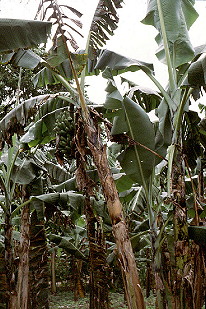The Bananas of Upland East Africa - INTRODUCTION |
| STOVER & SIMMONDS (1987) noted that the uplands to the west and north of Lake Victoria bear the greatest mass of bananas, genus Musa, in the world and that this cultivation is primarily of triploid acuminata types (often known as AAA types). The numerous clones, or somatic mutants, which collectively are the staple food, the principal component of banana beer and meet numerous domestic needs, are unique to the area with perhaps only one similar clone being known from outside East Africa, in the Madras area of India. As the origin of edible bananas is thought to be south Asia, the high level of cloning has been said to be evidence for a very long history of cultivation of bananas in the Lake Victoria area (BAKER & SIMMONDS 1951,1952; SHEPHERD 1957). This may well mean that research findings and agronomic practices from other, globally distant and botanically distinct, banana cultivations are not wholly applicable. In the area, however, the central role of bananas in the life and culture of the peoples gives the crop a crucial importance in the whole agricultural system. |  |
It is the almost unique but rarely heard of nature of the cooking banana as the staple food, "matoke", for several million people that has prompted me to create this web site. The format is an expansion from a published paper (TAYLOR, 1991) and provides an enhanced description of the geography of the Kagera region; greater details of the field trials; and more on the wide variety of clones. All this is accompanied with extensive illustrations from my own photographs.
Throughout the site, the small illustrations are clickable for viewing in a full page format, with accompanying text.
I have tried also to illustrate the real nature of conducting on-farm field studies. All too often, I have encountered a mind-set conditioned by what one might call the "Rothamsted" approach, influenced by the Fisher & Yates statistical methodology. This approach is very fine but hinges on having the nice well-ordered facilities and organisation of a sophisticated Research Station for one's studies. BUT, and this is the big BUT, subsistence farmers do not grow their crops in such a well-ordered and well-financed manner. Thus, if one wants (is employed) to study what influences crop productivity in a subsistence economy then it is necessary to make those studies on the actual farms (shambas in East Africa). Accordingly, I have given what some might consider to be an excess of details on the various field sites. Even then, the picture is incomplete, as it tells nothing of the simple problems, such as having to spend much of a day seeking out and obtaining fuel for project transport. Enough said except to add a note of protest against the tendency of funding agencies to send "experts" from the already mentioned well-ordered research establishments, University Departments, etc., out on "Evaluation Missions".
| The rationale for a programme of studies is followed by a description of the work that I organised in the period December 1987 to May 1990. For most of my career, I have tried to follow a "holistic" approach and, thus, endeavoured to gather and utilise as much data as possible from field studies. So, first, extensive surveys were made of all the main banana growing areas of the Region, leading to a delimitation of the areas, according to crop vigour and the observed constraints on production. Subsequent activities concentrated on the establishment of a number of simple "Demonstration and Evaluation field trials", which aimed to bridge the gap between the research and extension services; and two "Factorial trials" aimed at answering many of the questions regarding the crop, its husbandry and the potential for pest and disease management. Results covering the period from planting to first flowering and, in some cases, to harvest are given. Plant emergence; growth rates; sucker production; correlations between pseudostem girth and height; the very low incidence of banana weevil in growing plants; the high incidence of root damage characteristic of endoparasitic nematodes; and observations on several varieties are among the items discussed. The main factor affecting establishment and early growth of the crop appeared to be nutrition but, because variations in response to manure and pesticide were found to be site-specific, a cautionary approach to the ongoing rehabilitation of the crop is urged. The use of single stools as replicates was found to be a highly satisfactory experimental design for the factorial trials. |  |
E to this F |
 |
 |
None of the research work would have been possible without the very generous cooperation of numerous local farmers and the keen involvement of many government officers, especially the former Regional Agriculture Development Officer, Mr Joseph Shija, and his District Agriculture Development Officers. During the extensive surveys, Mr (now Dr) N.D. T. Rukazambuga, of Maruku Agricultural Research Institute gave particular assistance. Last but not least, my special thanks to Mr Ernest Sweya and his colleagues, Mr Geoffrey Kamando and Mr Christopher Manugulilo, of the Bukoba District agricultural extension staff. The work was done while I was Pest Control Scientist in the project Banana improvement and pest control in Kagera Region, Tanzania for Agristudio s.r.l., Florence, Italy. |  |
|
©2000, 2013 - Brian Taylor CBiol FSB FRES 11, Grazingfield, Wilford, Nottingham, NG11 7FN, U.K. Comments to dr.brian.taylor@ntlworld.com |
href="\BANANAS2000\BANINTRO.htm"